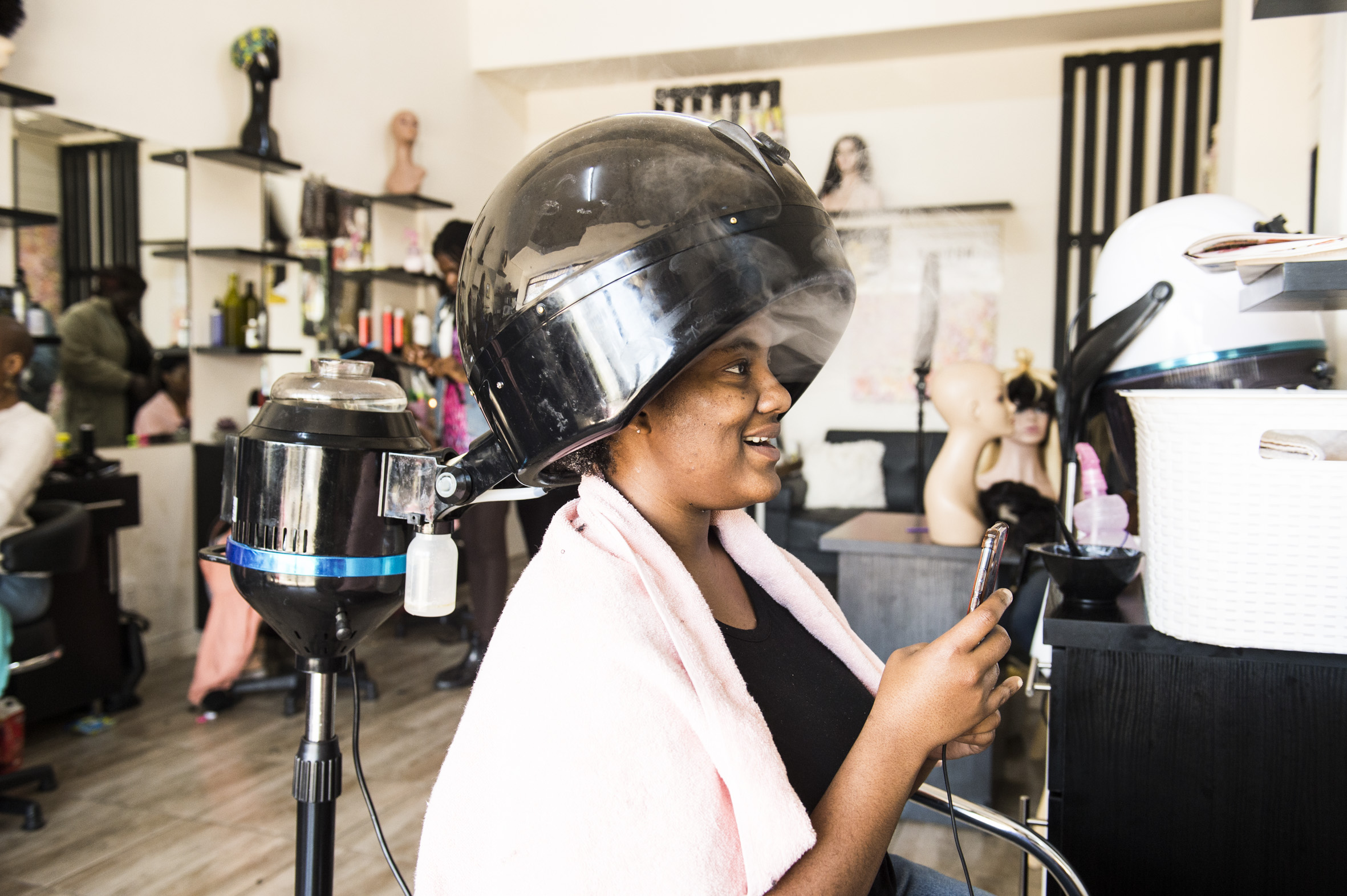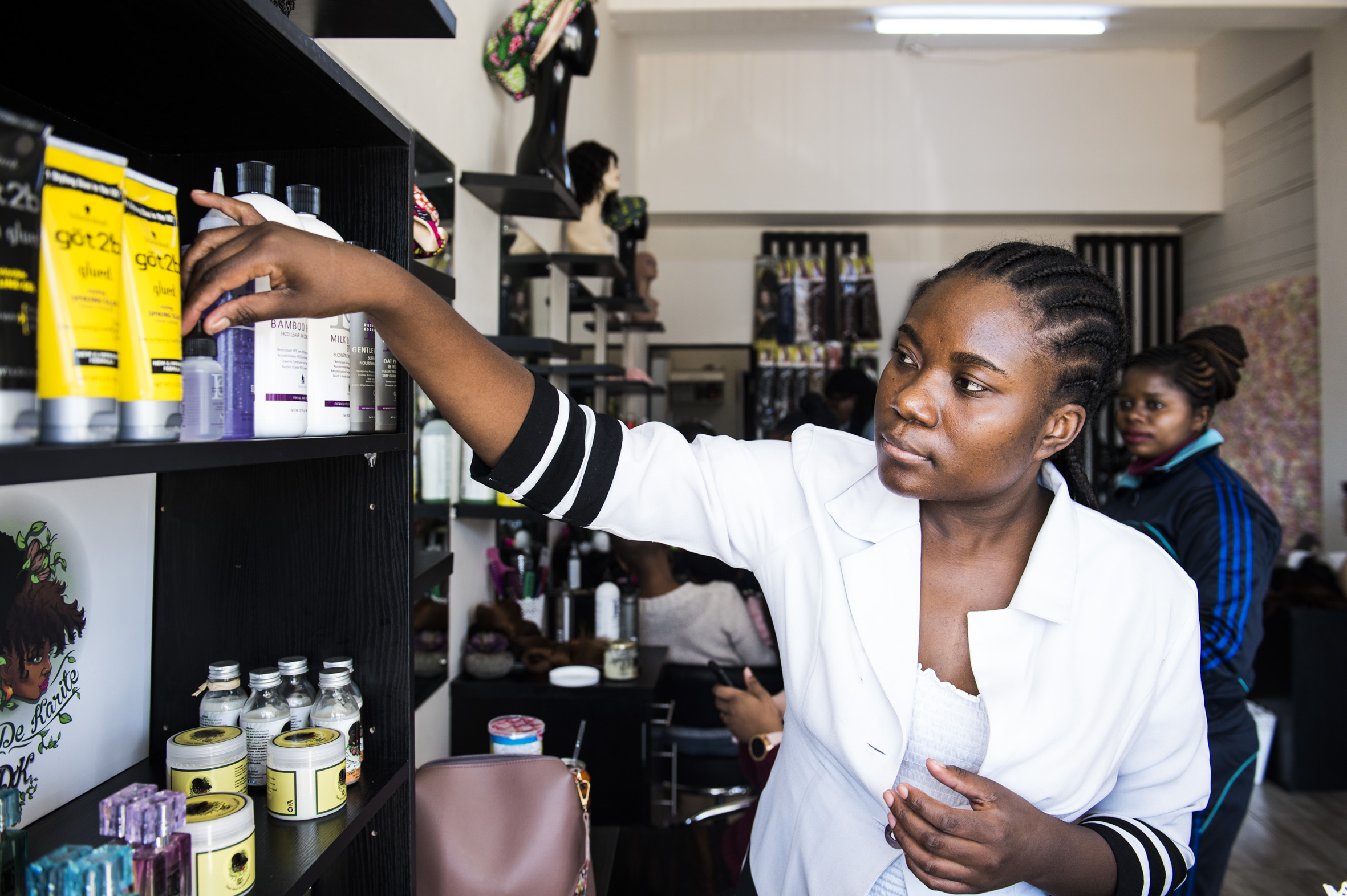The process that Shoosh Beauty Hair Salon follows for my appointment unfolds in four parts. (Delwyn Verasamy/M&G)
The natural hair community in South Africa is growing. However public knowledge of what to do with my hair is still stifled. So I do what anyone with internet access would do. I turn to bloggers and influencers in different regions with different hair textures, using their unaffordable niche brands to get mediocre results. And I do it at home.
Getting my hair done at a salon is a laborious process.
So whenever I am brave enough to leave the house to get my hair done, I do so armed with relentless determination. My weapons of choice are the phrases “No you can’t blow dry my hair”, “I prefer you using this shampoo because that one has sulphates” and “I brought my own comb, do you mind using it?” I have to stick by them no matter how big the lump in my throat gets when stylists start skinnering about my demands.

(Delwyn Verasamy/M&G)
When I do accept defeat and let the stylist blow dry my hair, I will spend the rest of my visit passing my stylist strands of fibre that will be worked into my coils for long cornrows or braids. I do not take a book with me to the hair salon. I do not go there to treat myself to some me-time. I go there to look good.
This is because even though there are hair salons specialising in the stylistic needs of black womxn on every and any corner of the country, not many of them have taken the time to educate their stylists on the processes that need to be followed when dealing with a natural hair clientele.
By processes I am referring to the actions taken to detangle, moisturise, trim, treat and protect one’s natural coils, with the goal of retaining healthy length as well as encouraging growth.
This is what BSc graduate Deborah Somwe (27) had in mind when she opened Shoosh Beauty Hair Salon four months ago.
Shoosh Beauty is a salon that specialises in the needs of natural hair, with a no heat (blow dryer) and no combing (to detangle hair) policy.

(Delwyn Verasamy/M&G)
Following a friend’s praises about their practice and process after a simple wash-and-go visit, I quickly followed suit.
The first few minutes of my appointment at Shoosh play out like a visit to the doctor’s office. After confirming my booking, my stylist asks to see my hair. Knowing that it is unwashed and uncombed, I squirm in response. She answers with a polite smile while leading me to a chair. “It’s okay. We’re here to take care of whatever’s underneath,” she says gesturing at my headscarf. “Now let’s see.”
Instead of immediately leading me to a basin after seeing how dirty my hair is, my stylists asks the following while checking the vitals of my hair:
How long have you been natural?
How long did you have you braids in for?
When was the last time you blow dried your hair?
What products do you use?
Are you comfortable with us using our product?
Confused about my hairstylist’s interest in my afro, I give curt answers. After unraveling my hair, she begins spritzing a cool concoction into it, gently pulling the coils apart.
“This will remove your build up and make it easier to wash,” she says about the contents she is applying to my hair. “It increases your porosity. That’s how well your hair takes in water and moisture. Once we’ve done this, we know that the treatments we’ll be giving you will definitely be absorbed.”
I nod slightly, afraid of asking if this will be an additional cost to my bill. “So this isn’t the treatment?” I ask. “Oh no, this is what the YouTubers call your pre-poo, the thing you do before you shampoo. We do that with all our clients.”
The process that Shoosh follows for my appointment unfolds in four parts. The porosity preparation, finger detangling and washing, a protein treatment, moisturising, and protective styling. I am there for a duration of six and a half hours.
Most of what the stylist does to my hair is foreign to me in a salon setting. She informs me on every step she takes, why it will benefit my hair and whether or not I am comfortable with it.
“I’m a black woman so there are things that I grew up hating about the salon experience. Stylists take charge instead of the client. We need to ask. Consent is all I wanted for myself. I took what I wanted for myself and made it available for everyone else,” explains Somwe.
Other ways in which Somwe attempts to make the experience an easy one is through installing a lay-down shampoo bed as an alternative to the reclining chair found at the washing station of most salons. “You never know how long it will take to detangle a client’s hair and the longer you sit in that chair the more uncomfortable it gets. So I though why not lay down while the stylists puts in the work.”
To ensure that these practices are carried out by all her stylists, Somwe personally trains each member of staff, whether permanent or freelancing.
The issue with this lies with the fact that the stylists may not have the same convictions as Somwe. While she may have been present for the better part of my appointment, she had to leave for personal matters. At that moment, the Shoosh ethos seemed to crumble.
Clients passed their own fibre and the detailed explanation of treatments fizzled into the atmosphere of fatigued stylists who had been on their feet all day.
In my case, once my treatment was complete and I had reached the final stage, where my hair was put into protective faux locks, I was left unattended for some time. Although I am not a hundred percent sure what my designated stylist was doing, and do not mind waiting, the courteous thing to do would have been to communicate the wait.
Other clients of Shoosh have made similar complaints. They say that while the treatment is outstanding, they too have had to wait for stylists to tend to them or, in some instances, arrive late to appointments made well in advance.
So while ethical practices for natural hair should be commended, they do not make up for this lapse in customer service.
Which brings me to the matter of pricing. While Shoosh prides itself in specialised and researched hair care, their prices are not for everyone. Factoring out occasional, promotions one can look at spending between R100 to R450 for a treatment, and R180 to R900 for protective hairstyles that range from flat twists to mid-back length braids. What makes the cost of all their protective styles relatively unaffordable is that they exclude the hair fibre needed. Seeing that my appointment involved a treatment and bob-length faux loc installation. Had it not been for a discount, my total would have been R850, excluding fibre.
Perhaps this is the nature of jobs that require unrelenting levels of servitude and a faultless skill set. Maybe it’s too much to ask of a stylist to attend to four consecutive customers, including installing box braids.
To install the faux locs, my stylist fuses fake dreadlocks with a portion of my hair. To do this she braids my hair around the loc and twists what remains of my hair into the faux fibre. Once you cannot tell this small portion of my hair apart from the dreadlock, she enforces the bond by sewing them together using a C-shaped needle and cotton thread that matches my hair colour. She repeats this process 69 times over, until I have a full head of realistic looking faux locs. She manages to do so with a strained smile.
How-not-to do your hair: a testimony
Step 1. Get a pair of scissors and cut your shoulder length braids into a bob just below the cheeks. Unravel them to reveal your hair, and the clay-like build-up of product that sits at your roots.
Step 2. Do your best to finger-comb out the product build-up without breaking your already brittle hair like the YouTube hair influencers told you to. Remember they, American women who have never seen your hair before, always know best.
Step 3. Wash out the remaining build up and general dirt that comes with keeping braids for two months. Do this using a black soap concoction you learned how to make through a Pinterest tutorial. Pray that the black soap is actually black soap
Step 4. Place all the essential oils you spent your savings on onto your head and massage as the cold water torments you by dripping down your neck.
Step 5. Succumb to the labour of sectioning your damp hair into twists because shrinkage is not an option. Wrap your hair in an old t shirt and wait 24 hours for your hair to dry.
Step 6. Eventually you will have to give into the financial and emotional expense of going to a salon to put your afro back into a protective hairstyle (braids, cornrows, faux locs etc).
Step 7. Repeat this every month